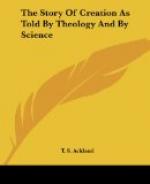The third objection, of course, ceases to have any force if the days of creation are no longer regarded as natural days. But the objection is in itself, apart from this condition, of no consequence whatever. For, in the first place, it is by no means certain, or even probable, that the stars referred to in the fourth day’s work are the fixed stars. The Hebrew has no word for planets as distinguished from the fixed stars, although, as we know for certain, the difference between the planets and the fixed stars was recognized from a very early period. In every case, then, the context must determine the sense to be given to the word. In this case, the fact that these stars are mentioned in connexion with the sun and moon, combined with our knowledge that the planets, like the moon, are dependent upon the sun for their light, would lead us to infer that they are meant.
But even if the fixed stars were meant, the objection would be no longer tenable. It rests on certain estimates as to the supposed distances of the fixed stars and star clusters, which were formed by the late Sir W. Herschel from what he designated the “space-penetrating power” of his telescopes. Starting with the assumption that the stars were of tolerably uniform size and brilliancy, and that the difference in apparent brightness was the result, and therefore a measure of their distances, he proceeded to apply the same process to the star clusters, which, even in a fair telescope, present only the appearance of faint nebulous spots of light, but are resolved into clusters of stars by more powerful instruments. In many cases, he found that a certain proportion existed between the telescopic power by which a cluster was first rendered visible, and that required for its resolution, and by this means he formed what he considered a probable estimate of its distance. Other clusters there were which only became visible in his most powerful telescopes, and which, therefore, he could never succeed in resolving. These he placed at a still greater distance, and from this estimate he deduced the conclusion that their light must have been in some cases as much as 60,000 years in reaching the earth.
But the whole foundation on which this long chain of inference rested has now been shown to be evanescent. In the first place many of his irresolvable nebulae have been proved by the spectroscope to be true nebulae—masses of luminous gas, and not star clusters at all; and, in the next place, the actual distances of a few of the fixed stars have been approximately ascertained, and it is proved beyond all doubt that the different degree of brightness exhibited by different stars is no test at all of their distance. Of all the stars in our hemisphere whose distance has thus been measured, the nearest to us is one which can only just be discerned by a practised eye on a favourable night, 61 Cygni, whilst the most brilliant star visible in England, Sirius, is at a considerably greater distance.




